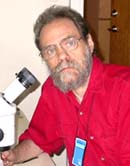
Julio Ferrer
PH D
e-mail: 
Location: Sweden
Curriculum vitae:
Julio Ferrer Mariné is born in Spain, Madrid, 1944.
1959 Frequenting the Museo de Ciencias Naturales, Madrid as young scholar, Julio will be initiated in entomological studies by eminent spanish specialists: Dr Luis Báguena (Scarabaeoidea) and Francisco Espanol (Tenebrionidae). Julio started his first collection of insects.
1960 As results of political agitation against the dictator Francisco Franco, Julio is prosecuted with other students, incarcered (1962), processed, released and forced to the exile.
1966-1969 Julio visit France, Italy and China, establishing his permanent domicile in Stockholm, Sweden.
1970-1989 Julio completing a Ph D examen in social anthropology (Etnologi), Stockolms Universitet 1981, leaded by Prof. Åke Daun.
His research is centered in death, insects and mythology. Other current research included the Tenebrionidae, under the mentorship of the great french specialist Paul Ardoin and the hungarian Zoltan Kaszab. Julio is admitted to the Entomological Society of Stockholm, obtaining access to the Departement of Entomology of the Swedish Museum of Natural History, Stockholm. Julio is actually the Secretary of this Society.
Julio collected self beetles in several Mediterranean and North African countries under years and worked for several swedish institutions in Stockholm, as the High School of Technology, The Nordic Museum, the International Art School, The University of Agriculture of Uppsala, The Ministery of Agriculture (Jorbruksverket) and the Birkagarden.
Moreover about 130 entomological papers, Julio is writter of three books focusing modern aspects of social life in Sweden : I väntan på döden, Academy Litteratur, 1981, Punkare och Skinheads, Norstedts 1983 and Moderna myter och gamla brott, Norstedts, 1984.
Julio described 2000, the largest Tenebrionidae of the world (7,9 cm), the new species Pheugonius mjoebergi from Borneo, exposed under 50 years in the Swedish Museum of Natural History, misidentified as "Pheugonius gigas Gebien".
Julio his sponsored under 2002-2005 by several scientific europeans programs (COLPARSYS, SYSRESOURCE, SYNTHESE) for study of the scientific museal infrastructures (preserved entomological collections).
Julio has identified material from several Museums institutions and private collectors and is owner of one of the greates collections of Tenebrionide of the Nordic countries.
Zoologiska Museet, Lund Universitet, Sweden, Naturhistoriska riksmuseet, Stockholm.
The Natural History Museum, London, Museum für Naturkunde, Humboldt Universität zu Berlin, Museum Royal de l´Afrique centrale, Tervuren, Belgien, Museum national d´Histoire naturelle, Paris, Consejo Superior de Investigaciones científicas y Museo de Ciencias naturales de Madrid, Museum and Institute of Zoology, Academy of Sciences of Warszawa, Transvaal
Museum, Pretoria, R. of South Africa, National Museum of Namibia, Windhoek and Instituto
Argentino de Zonas Aridas, Mendoza, Argentina.
List of publications
|

